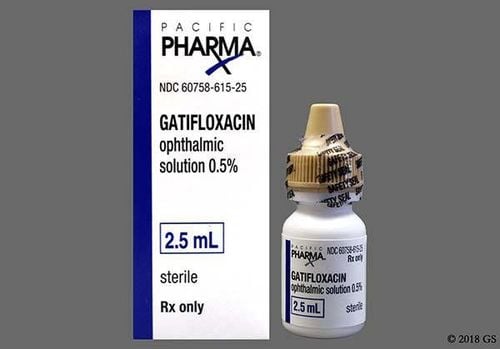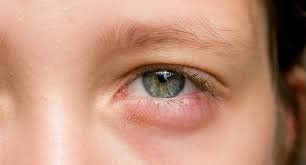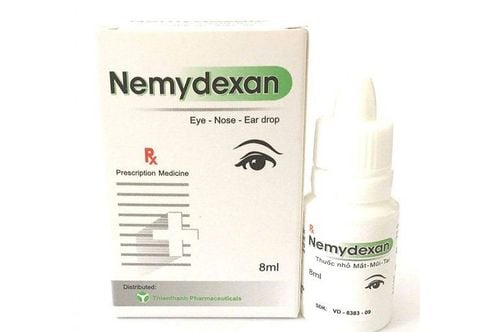This is an automatically translated article.
The article is expertly consulted by Master, Doctor Phan Thi Cam Van - Department of Pediatrics - Neonatology - Vinmec International General Hospital Da Nang. Dr. Van has 07 years' experience as a Resident Doctor and a Pediatrician - Neonatologist at Hue Central Hospital and Hue University Hospital of Medicine and Pharmacy. In particular, Dr. Van has strengths in newborn care and treatment, neonatal resuscitation, respiratory diseases, digestion, feeding, common problems in newborns.Neonatal conjunctivitis is a fairly common eye disease, with the most common sign being red eyes. Because newborn babies have weak immune systems, if conjunctivitis is not treated in time, it can lead to dangerous complications, causing blindness.
1. Causes and symptoms of neonatal conjunctivitis
Newborns with conjunctivitis typically have red, swollen eyelids. Neonatal conjunctivitis can be caused by blocked tear ducts, viral or bacterial infections passed from mother to baby.Common types of neonatal conjunctivitis include:
1.1 Chlamydia Chlamydia trachomatis conjunctivitis can cause conjunctivitis and genital infections. Women with untreated chlamydia before giving birth can pass it on to their babies.
Symptoms of Chlamydia conjunctivitis, including redness, swelling of the eyelids, and purulent discharge, appear 5 to 12 days after birth.
About half of babies with chlamydial conjunctivitis also have infections in other parts of the body. The bacteria can infect the lungs and nasopharynx.
1.2 Neisseria gonorrhoeae conjunctivitis causes gonococcal conjunctivitis. Women with untreated gonorrhea can pass the bacteria on to their babies during delivery.
Symptoms usually include red eyes, thick pus-like discharge, and swelling of the eyelids. This type of conjunctivitis usually begins 2-4 days after birth, may be accompanied by blood infection, encephalitis - meningoencephalitis.
1.3 Allergic conjunctivitis eye drops When an infant is given eye drops to help prevent bacterial infection, the eyes may become irritated, having an allergic reaction. Symptoms of eye drop allergy usually include mild red eyes, in some cases swelling of the eyelids. These symptoms can last for as little as 24 to 36 hours.
1.4 Other viral and bacterial conjunctivitis Viruses and bacteria other than the two above can cause quite a lot of conjunctivitis. For example, bacteria that live in the mother's vagina and are not sexually transmitted can also cause conjunctivitis.
In addition, the viruses that cause genital and oral herpes can also cause neonatal conjunctivitis and serious eye damage. A mother can pass the virus to her baby during birth.
Herpes virus conjunctivitis is less common than gonorrhea and chlamydia. Symptoms include red eyes and swollen eyelids, in some cases accompanied by pus.

Mẹ bầu cần được chữa các bệnh có thể lây vi khuẩn, virus cho trẻ
2. Treatment of conjunctivitis in infants
In the past, the treatment of conjunctivitis in infants was usually silver nitrate, but now there has been an alternative to antibiotic eye drops. Neonatal conjunctivitis caused by a bacterial infection can be treated, depending on the severity of the infection and the underlying cause.Some mild conditions will require antibiotics such as eye drops or ointment. Other antibiotics are given orally or intravenously. Treatment of conjunctivitis in infants if the disease is severe can combine topical drops, oral antibiotics, intravenous injection. Irrigation of the infected eye with a saline solution will help remove accumulated pus and some of the causative agent.
Conjunctivitis caused by blocked tear ducts can be treated by gently massaging the area between the eyes and nose. If the disease does not resolve after 1 year of age, it may be necessary to intervene with a routine procedure...
For each group of viral or bacterial causes of neonatal conjunctivitis there are specific treatment options. .
2.1 Chlamydia conjunctivitis Usually oral antibiotics such as erythromycin are used. It is not possible to treat only topically because the bacteria in the nasopharynx cannot be eliminated, which can cause dangerous pneumonia.
The therapeutic effect of systemic erythromycin is about 80%, so it is often combined with topical antibiotics such as erythromycin ointment.
2.2 Gonococcal conjunctivitis Often combined with instillation, aggressive medication, severe conditions should consider intravenous (IV) antibiotics for treatment. If not treated well, children can develop corneal ulcers and easily lead to blindness.
2.3 Drug-allergic conjunctivitis Stop instillation, change the medicine for the child, the child will usually get better after 24 to 36 hours, at the same time combine with the care with medication.

Rửa mắt cho trẻ bằng nước muối rất tốt
Viral conjunctivitis, the main treatment is to help reduce irritation with anti-inflammatory drugs, use lubricating drugs to protect the eyeball.
The treatment of conjunctivitis in newborns is mostly not too complicated, it is important for parents to detect it early and take the child to the doctor. If your newborn has any symptoms of conjunctivitis, take them to an ophthalmologist or pediatrician right away.
3. Prevention of conjunctivitis in infants
Pregnant women during pregnancy need to be monitored, tested for and excluded some diseases such as gonorrhea, syphilis ...During pregnancy and before giving birth, women infected with viruses and bacteria should consult Doctors look for ways to minimize the risk of transmission to the child. In addition, if the child shows abnormal signs, especially signs of conjunctivitis, parents need to take the child to a medical center for examination and treatment, to avoid dangerous complications. to children's eyesight.
As a key area of Vinmec Health system, Pediatrics Department always brings satisfaction to customers and is highly appreciated by industry experts with:
Gathering a team of top doctors and nurses in Pediatrics : consists of leading experts with high professional qualifications (professors, associate professors, doctorates, masters), experienced, worked at major hospitals such as Bach Mai, 108.. Doctors All doctors are well-trained, professional, conscientious, knowledgeable about young psychology. In addition to domestic pediatric specialists, the Department of Pediatrics also has the participation of foreign experts (Japan, Singapore, Australia, USA) who are always pioneers in applying the latest and most effective treatment regimens. . Comprehensive services: In the field of Pediatrics, Vinmec provides a series of continuous medical examination and treatment services from Newborn to Pediatric and Vaccine,... according to international standards to help parents take care of their baby's health from birth to childhood. from birth to adulthood Specialized techniques: Vinmec has successfully deployed many specialized techniques to make the treatment of difficult diseases in Pediatrics more effective: neurosurgery - skull surgery, stem cell transplantation. blood in cancer treatment. Professional care: In addition to understanding children's psychology, Vinmec also pays special attention to the children's play space, helping them to have fun and get used to the hospital's environment, cooperate in treatment, improve the efficiency of medical treatment.
Please dial HOTLINE for more information or register for an appointment HERE. Download MyVinmec app to make appointments faster and to manage your bookings easily.













